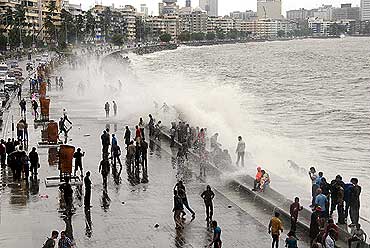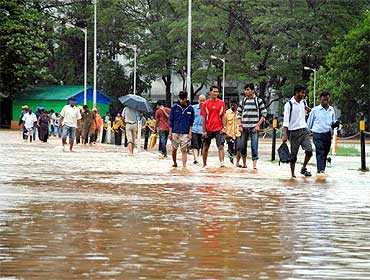 | « Back to article | Print this article |
Why it may not flood in Mumbai this monsoon
The monsoon has finally arrived in India's financial capital, leaving many citizens in fact worried. Will there be floods in Mumbai once the monsoon gets active? A repeat of the dreaded July 2005 floods? The answer is NO, if the Municipal Corporation of Greater Mumbai or BMC is to be believed.
"It is our aim that in the near future, streets of Mumbai witnesses minimum or zero-flooding during the rains," said Aseem Gupta, BMC additional commissioner.
The civic body's confidence stems from the success from the pumping station projects at Irla and Haji Ali.
For the first time in the history of the western suburbs in Mumbai no flooding was witnessed at Milan Subway on Tuesday.
Till last year, Milan Subway near Santa Cruz was known as the hotspot for photojournalists who would find knee-deep flooding even after a persistent drizzle.
Though the monsoon is still in the initial stages, the city has already received 265 mm of rainfall compared to 5 mm in 2009 till June 15.
Mumbai may have a flood-free monsoon
Why Mumbai floods?
As the city is an island, due to lack of planning and haphazard development much of the city land mass is close to the sea level. When it rains, the storm water is routed to the sea through the antiquated drainage system (some of them in use have been built by the British).
The system works well when it rains about 40 mm per hour at low tide. The scenario changes drastically when it rains more than 40 mm per hour or the sea is at a high tide.
Since the existing drainage system cannot handle more than 40 mm rainfall per hour, it results in flooding. With the sea level rising, the gates of the stormwater drains exiting into the sea have to be shut to prevent the sea water from coming into the city.
Mumbai may have a floods-free monsoon
How to prevent flooding
Pumping stations were planned by the BMC to tide over the flooding problem. The storm water is routed to the pumping station from where it pumped into the sea at high tide Though the concept of pumping stations has been in the pipeline for several years, this year the civic body got encouraging results from the recently installed pumping stations at Irla and Haji Ali. The Irla pumping station covers JVPD scheme, Juhu, D N Nagar, Parle and Andheri region.
While Haji Ali pumping station covers parts of Worli, Tardeo, Mumbai Central and Nana Chowk. With the initial rainfall Mumbai received, the regions covered by the pumping stations were not flooded. "We are happy with the results of our experimentation with pumping stations," said additional commissioner Gupta.
Mumbai may have a flood-free monsoon
Floods may be thing of the past, says BMC
With the success of the two pumping stations, the civic body plans to install more of those near "chronic flooding" spots. One is being planned at Reay Road which will cover regions of Wadala, Hind Mata, Lower Parel and Reay Road. Also two more have been planned at Worli Love Grove and Cleaveland. The pumping station at Love Grove has been hampered by the issues of encroachment and rehabilitation of project-affected persons.
"Pumping stations to tackle chronic flooding spots in other parts of the city will be taken up after this monsoon," said Gupta.
Moreover, the city has undertaken 58 projects to improve the intake capacity of the city's ailing storm water drain system. Eleven of these projects have been completed while remaining are in the various stages of completion. Once all the projects to improve the storm water drains are made then the system would be able to handle 50 mm to 60 mm of rainfall at low tide.



